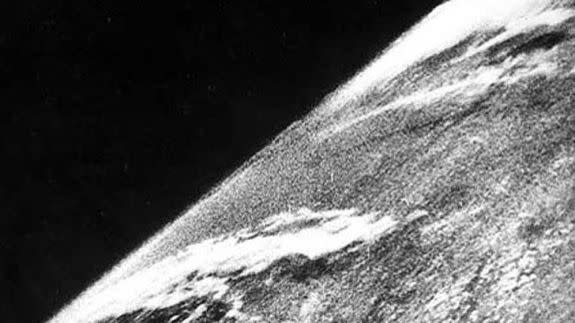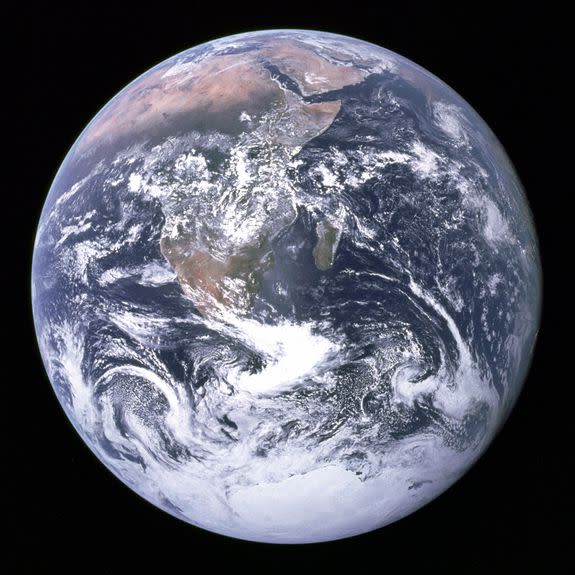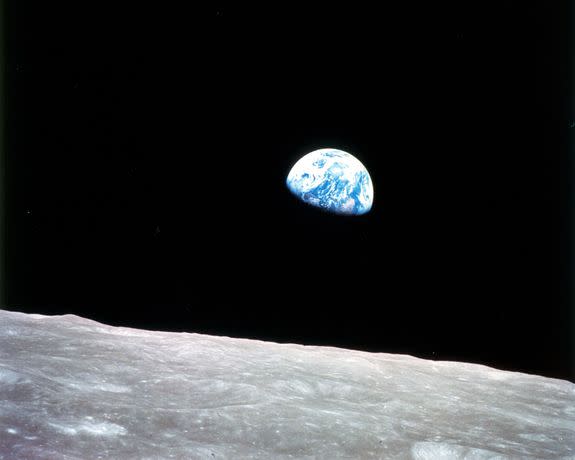The first photo of Earth from space was taken 70 years ago

Seventy years ago today, humans took a photo of our home planet as seen from space for the first time.
The image itself is unassuming.
Taken from aboard a Nazi-built V2 rocket on Oct. 24, 1946, the black and white photo shows a smattering of clouds casting shadows down upon our planet.
SEE ALSO: NASA will show the world new 'blue marble' photos of Earth every day
The photo was taken from about 105 kilometers (65 miles) above Earth by a rocket launched from the White Sands Missile Range long before Sputnik truly began the space age in 1957.
Unbeknownst at the time to the American scientists and engineers who launched the rocket, that photo was humanity's first salvo into what has become one of the most important uses for spaceflight yet discovered.
70 years ago #today in 1946, White Sands Missile Range scientists launched V-2 No. 13 & took the 1st pictures of Earth from space, 105 km up pic.twitter.com/a1hvMchR2x
— NASA History Office (@NASAhistory) October 24, 2016
Since 1946, Earth imaging has become an integral part of government as well as private work.
Taking photos of Earth from above isn't just about tracking weather or even spying. Photos taken of the planet by commercial satellites are used to show people the world through applications like Google Earth. Some organizations also hope to track issues like deforestation or even poverty using the bird's eye view of our home planet.
NASA and other space agencies around the world keep an eye on our planet from above using a variety of satellites equipped with cameras designed to monitor Earth's weather and other systems.
And these satellites have delivered some incredible views of our planet back to people on the ground.
A camera onboard the Deep Space Climate Observatory, located about 1 million miles from Earth, takes an image of the full, sunlit side of the planet every two hours.
In these photos, the world shines like a blue marble against the blackness of space and are designed to show people what they would see if they were to fly out to where the observatory is located.
And of course, since 1946, people have also traveled off the planet and seen their first glimpses of Earth from hundreds of kilometers above.
"Being in space for a whole year, you get this perspective of seeing the Earth through changing seasons and you know, different lighting conditions," former NASA astronaut Scott Kelly, who recently returned from spending a year on the International Space Station, said during a visit to the White House last week.
One view of Earth, taken during the Apollo 17 mission to the moon, shows the planet as a blue marble with the African continent visible in 1972.

Image: NASA
Apollo astronauts were also treated to views of the Earth rising above the moon's horizon.
According to many people who have flown to space, seeing the Earth from above is a transformative experience.
Many astronauts and cosmonauts who have visited space in the decades since Yuri Gagarin first went to orbit in 1961 talk about a shift in perspective that happens when a person spends time above the planet.

Image: nasa
Called the "overview effect" by some of those that have experienced it, this change in perspective usually involves coming to the understanding that all humans are sheltered by the same thin atmosphere, and borders between nations don't exist in space.
"Looking down at the Earth and you see that line that separates the day into night slowly moving across the planet, thunderstorms on the horizon casting these long shadows as the sun sets, and then watching the Earth come alive and you see the lights from the cities and the towns," former NASA astronaut Ron Garan said in a short film about the overview effect.
And of course, because of that, some people shift the way they see the planet even when they head back down to the ground.
"You also notice how the atmosphere looks and how fragile it looks," Kelly said just before coming back to Earth after his year in space. "It makes you more of an environmentalist after spending so much time looking down at our planet."
